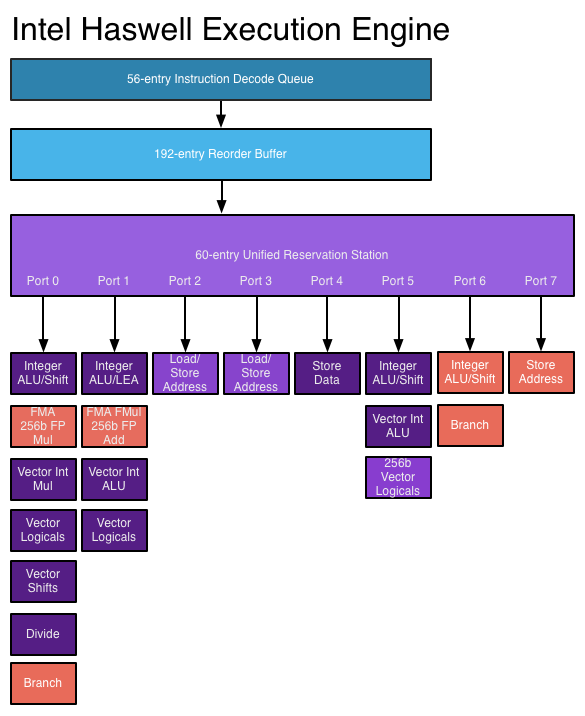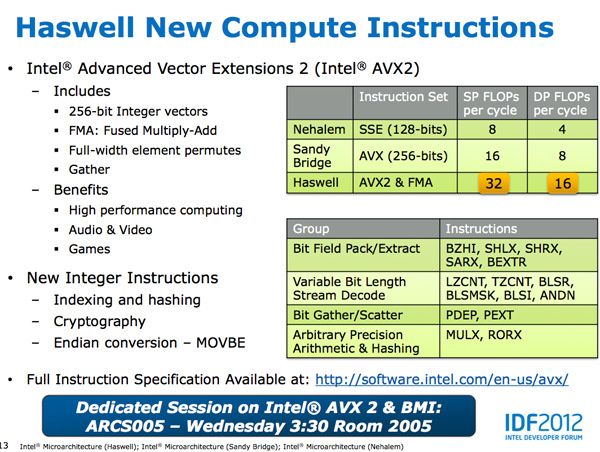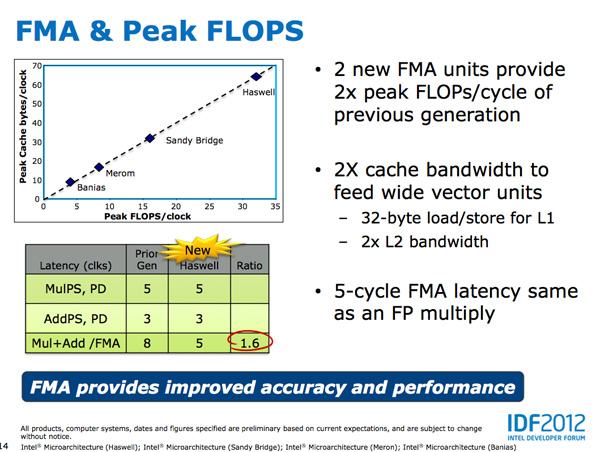Intel's Haswell Architecture Analyzed: Building a New PC and a New Intel
by Anand Lal Shimpi on October 5, 2012 2:45 AM ESTHaswell's Wide Execution Engine
Conroe introduced the six execution ports that we've seen used all the way up to Ivy Bridge. Sandy Bridge saw significant changes to the execution engine to enable 256-bit AVX operations but without increasing the back end width. Haswell does a lot here.
Just as before, I put together a few diagrams that highlight the major differences throughout the past three generations for the execution engine.

The reorder buffer is one giant tracking structure for all of the micro-ops that are in various stages of execution. The size of this buffer is directly impacted by the accuracy of the branch predictor as that will determine how many instructions can be kept in flight at a given time.
The reservation station holds micro-ops as they wait for the data they need to begin execution. Both of these structures grow by low double-digit percentages in Haswell.
Simply being able to pick from more instructions to execute in parallel is one thing, we haven't seen an increase in the number of parallel execution ports since Conroe. Haswell changes that.
From Conroe to Ivy Bridge, Intel's Core micro-architecture has supported the execution of up to six micro-ops in parallel. While there are more than six execution units in the system, there are only six ports to stacks of execution units. Three ports are used for memory operations (loads/stores) while three are on math duty. Over the years Intel has added additional types and widths of execution units (e.g. Sandy Bridge added 256-bit AVX operations) but it hasn't strayed from the 6 port architecture.
Haswell finally adds two more execution ports, one for integer math and branches (port 6) and one for store address calculation (port 7). Including both additional compute and memory hardware is a balanced decision on Intel's part.
The extra ALU and port does one of two things: either improve performance for integer heavy code, or allow integer work to continue while FP math occupies ports 0 and 1. Remember that Haswell, like its predecessors, is an SMT design meaning each core will see instructions from up to two threads at the same time. Although a single app is unlikely to mix heavy vector FP and integer code, it's quite possible that two applications running at the same time may produce such varied instructions. Having more integer ALUs is never a bad thing.
Also using port 6 is another unit that can handle x86 branch instructions. Branch heavy code can now enjoy two independent branch units, or if port 0 is occupied with other math the machine can still execute branches on port 6. Haswell moved the original Core branch unit from port 5 over to port 0, the most capable port in the system, so a branch unit on a lightly populated port makes helps ensure there's no performance regression as a result of the change.
Sandy Bridge made ports 2 & 3 equal class citizens, with both capable of being used for load or store address calculation. In the past you could only do loads on port 2 and store addresses on port 3. Sandy Bridge's flexibility did a lot for load heavy code, which is quite common. Haswell's dedicated store address port should help in mixed workloads with lots of loads and stores.
The other major addition to the execution engine is support for Intel's AVX2 instructions, including FMA (Fused Multiply-Add). Ports 0 & 1 now include newly designed 256-bit FMA units. As each FMA operation is effectively two floating point operations, these two units double the peak floating point throughput of Haswell compared to Sandy/Ivy Bridge. A side effect of the FMA units is that you now get two ports worth of FP multiply units, which can be a big boon to legacy FP code.
Fused Multiply-Add operations are incredibly handy in all sorts of media processing and 3D work. Rather than having to independently multiply and add values, being able to execute both in tandem via a single execution port increases the effective execution width of the machine. Note that a single FMA operation takes 5 cycles in Haswell, which is the same latency as a FP multiply from Sandy/Ivy Bridge. In the previous generation a floating point multiply+add took 8 cycles, so there's a good latency improvement here as well as the throughput boost from having two FMA units.

Intel focused a lot on adding more execution horsepower in Haswell without creating a power burden for legacy use cases. All of the new units can be shut off when not in use. Furthermore, Intel went in and ensured that this applied to the older execution units as well: in Haswell if you're not doing work, you're not consuming power.












245 Comments
View All Comments
A5 - Friday, October 5, 2012 - link
8 years is a loooooong time in this space, and yes you (and most people here) are in the minority.Notebooks have been outselling desktops for several years, and in 2011 smartphone shipments were higher than all PC form-factors combined. It's pretty clear where the big bucks are going, and it isn't desktop PCs.
flamethrower - Friday, October 5, 2012 - link
In 8 years you'll have 50-inch OLED TVs on your walls. What's going to drive them? Possibly a computer integrated into them.Peanutsrevenge - Friday, October 5, 2012 - link
We'll just be using large screens, keyboards and mice wireless connected to our ultra portable devices.The desktop will likely still exist for people like us who frequent this site, however it's role will be far more specialised, possibly more as our personal cloud servers than our PCs.
yankeeDDL - Friday, October 5, 2012 - link
Wow. Thanks for the excellent article: I really enjoyed it.The thought of having a processor of the power level of Ivy bridge in my mobile phone blows my mind.
Honestly though, I really can't see how the volume of CPUs for desktop PCs and servers is going to drop so dramatically, that Intel will need the volume generated by mobile, to "survive".
Yes, of course more volume will help, but 8 years from now, even if the mobiles will have such kind of computational power, I would imagine that a Desktop would have 10~20x that performance, as it is today.
It's true that today's CPUs are typically more powerful than the average user ever needs, but raise the hand who wouldn't trade his CPU for one 10x faster (in the same power envelope) ...
That said, 10W still seems like a lot to fit in a mobile: who knows the power consumption of high-end mobile CPUs today? (quad-core Krait CPU, for example, or even Tegra3)
dagamer34 - Friday, October 5, 2012 - link
Intel's real problem is that the power needed for "good enough" computing in a typical desktop CPU came a couple of years ago Nd is rapidly approaching in mobile. With more and more tasks being offloaded to the cloud, battery life is becoming a stronger and stronger focus.What's sad is that because AMD isn't the major player it once was, Intel has allowed it's eye off the ball, revving Atom with only minor tweaks and having a laissez faire approach to GPU performance. It's only been recently when mobile has started to dominate in the minds of consumers and Intel's lack of any major design wins (the RAZR I doesn't count) which has forced Intel to push as hard as it is now.
sp3x0ps - Friday, October 5, 2012 - link
Where is the iPhone 5 review? I need details!! arghh.Demon-Xanth - Friday, October 5, 2012 - link
Atom was targeted to UMPCs, but quickly took over low power embedded systems who don't need much power but do run Windows.tipoo - Friday, October 5, 2012 - link
Poor Via.dgingeri - Friday, October 5, 2012 - link
"Within 8 years many expect all mainstream computing to move to smartphones, or whatever other ultra portable form factor computing device we're carrying around at that point."They said the same thing about laptops. Sure, laptops hold about 60-65% of the market these days, but the desktop is still very much around, and is the preferred platform for PC gamers and HTPC applications. They're far more flexible than any mobile form factor.
Smartphones also have the severe disadvantage of a very small screen. Even the largest are too small for most people to deal with. On top of that, actually surfing the net on those tiny screens is an exercise in frustration for many people. I try to tap on a link, only to get the link next to it, or above it, or below it, or possibly having my stupid phone just select the text instead of following the link.
Smartphones have their niche. There's no doubt there, but they are not going to be anyone's mainstream device unless they have needle thin fingers and 20/10 vision.
Anand Lal Shimpi - Friday, October 5, 2012 - link
I agree with the notebook/desktop comparison - these form factors won't go away. I should have said the majority of mainstream client computing goes to smartphones. And solving the display and input problems is easy: wireless display (WiDi/Miracast) and wireless keyboard/mouse (or a dock that does both over wires if you'd rather that).Take care,
Anand